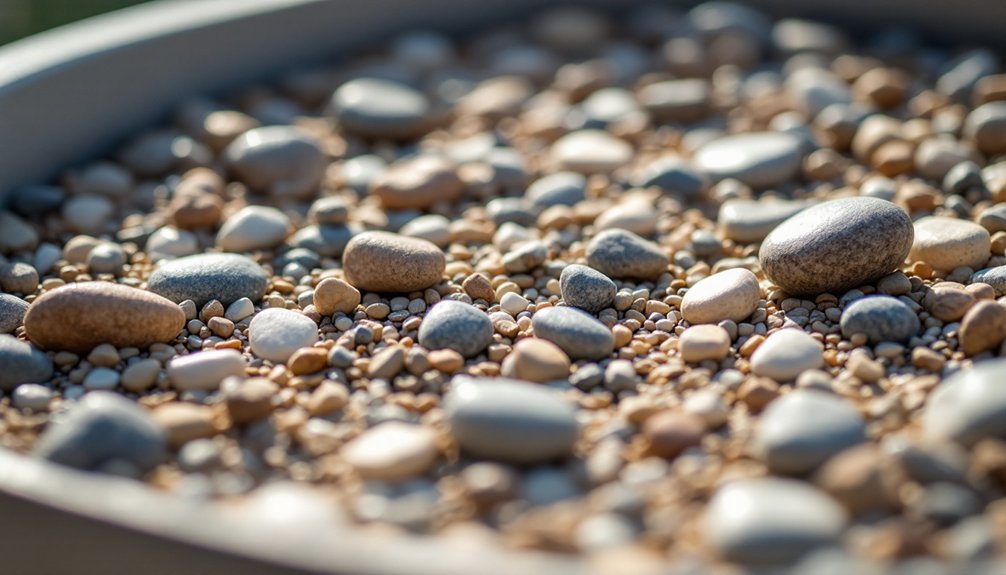Adding pebbles or gravel to the bottom of your plant containers won't improve drainage like you might think. Instead, it creates what's called a "perched water table" that actually traps moisture above the rocks, increasing the risk of root rot. You'll get much better results by using high-quality potting soil and ensuring proper drainage holes in your containers. Understanding the science behind water movement in container soils can transform your gardening success.
Understanding Water Movement in Container Soils

When you plant in containers, understanding how water moves through soil is essential for your plants' health.
Water movement in potting mix relies on two main forces: gravity pulling it downward and capillary action drawing it upward through tiny soil pores. This balance is vital for proper soil drainage and healthy roots.
You might think adding gravel at the bottom of your container helps drainage, but it actually creates problems.
When water moves from soil to gravel, it forms a perched water table – a zone where water collects above the gravel layer. This happens because water won't flow into larger spaces until the soil above is completely saturated.
The result? Your plants' roots sit in waterlogged soil, increasing their risk of root rot.
The Science Behind Perched Water Tables
Despite sounding counterintuitive, the science behind perched water tables explains why adding gravel to container bottoms actually worsens drainage.
When you place gravel below soil, you're creating a situation where water gets trapped above the gravel layer due to differences in pore sizes between materials.
Your potting soil's smaller particles create stronger capillarity, holding water more effectively than the larger gravel pieces below. Rather than improving drainage, this difference in particle size creates a perched water table, where excess moisture remains suspended above the gravel layer – even with drainage holes present.
This trapped water won't drain efficiently, increasing your plants' risk of root rot. Research shows the height of this water table stays constant whether you use gravel or not, eliminating any potential drainage benefits in container gardening.
Optimal Materials for Container Drainage

Now that we comprehend why gravel layers don't work, let's focus on materials that actually improve container drainage. Quality potting mixes combined with proper drainage holes are your best defense against root rot. You'll want to avoid creating a perched water table by skipping gravel in pots altogether. Instead, mix soil components thoroughly to guarantee excess water flows freely through your growing medium.
| Material | Benefit |
|---|---|
| Perlite | Improves aeration and prevents soil compaction |
| Vermiculite | Retains moisture while maintaining drainage |
| Coarse Sand | Creates consistent pore spaces |
| Premium Potting Mix | Provides balanced nutrition and drainage |
| Breathable Pots | Allows moisture evaporation through walls |
For healthy root systems, invest in quality potting mixes specifically designed for your plants. Remember, proper mixing of components beats layering every time.
Common Misconceptions About Rock Drainage
Throughout gardening history, the practice of adding rocks to container bottoms has persisted as one of the most widespread yet misunderstood techniques. You might've heard that placing gravel at the bottom of your containers improves drainage, but this common gardening myth actually does more harm than good.
When you add rocks beneath potting soil, you're creating a perched water table, where water gets trapped above the rock layer instead of draining freely. This happens because water doesn't move easily from fine soil particles into larger spaces between rocks.
The result? Your plant roots face an increased risk of root rot, and you've reduced the volume of soil they can grow in. Instead of using gravel for drainage, you'll get better results by choosing a high-quality potting soil that contains materials like perlite or vermiculite.
Best Practices for Plant Container Setup

Setting up your plant containers correctly can make all the difference between thriving plants and struggling ones. You'll want to focus on proper drainage to prevent root rot, but skip the old practice of placing gravel beneath your soil. Instead, improve drainage by using well-balanced potting mixes enhanced with perlite, vermiculite, or coarse sand.
Your containers must have adequate drainage holes to prevent a saturated zone from forming. Cover these holes with coffee filters or mesh to prevent soil from washing out while ensuring water runs freely.
When you're potting, choose containers that match your plant's size and check regularly for clogged drainage holes. If you notice compacted soil or poor drainage, don't hesitate to repot plants into fresh medium with proper drainage properties.
Frequently Asked Questions
What Is the Best Thing to Put in the Bottom of Pots for Drainage?
Don't add anything to your pot's bottom – just use quality potting mix and guarantee proper drainage holes. If you're worried about soil loss, cover holes with a coffee filter or mesh screen.
Do Pebbles Help With Drainage?
No, pebbles don't help with drainage – they actually make it worse by creating a perched water table. You'll get better results by using well-draining potting mix and ensuring your pot has proper drainage holes.
Should You Put Pebbles in the Bottom of a Planter?
No, you shouldn't put pebbles in the bottom of your planter. It's actually counterproductive, as it raises the perched water table and reduces soil volume. Instead, use quality potting mix and proper drainage holes.
Why Do People Put Rocks at the Bottom of Pots?
People put rocks in pots because of an old gardening myth that it improves drainage. However, you shouldn't follow this practice as it actually creates drainage problems and reduces the space for healthy root growth.
In Summary
You've learned that using pebbles and gravel for container drainage isn't as effective as once thought. Instead of improving drainage, these materials create a perched water table that can harm your plants. You'll get better results by using well-draining potting soil throughout the container and ensuring proper drainage holes. Focus on soil quality and container design rather than adding rocks to the bottom.





Leave a Reply